Matilda of England, Duchess of Saxony
Last updated| Matilda | |
|---|---|
 Matilda depicted at her wedding in the Gospels of Henry the Lion | |
| Duchess consort of Saxony and Bavaria | |
| Tenure | 1 February 1168 – 1180 |
| Born | June 1156 London, England |
| Died | June/July 1189 (aged 32–33) Brunswick, Lower Saxony |
| Burial | Brunswick Cathedral, Lower Saxony |
| Spouse | |
| Issue | Matilda, Countess of Perche Henry V, Count Palatine of the Rhine Otto IV, Holy Roman Emperor William, Lord of Lüneburg |
| House | House of Plantagenet |
| Father | Henry II of England |
| Mother | Eleanor of Aquitaine |
Matilda of England (June 1156 — June/July 1189) was an English princess of the House of Plantagenet [lower-alpha 1] and by marriage Duchess consort of Saxony and Bavaria from 1168 until her husband's deposition in 1180.
Contents
Life
Matilda was born in or around June 1156 in London or, less likely, at Windsor Castle, [1] as third child and eldest daughter of King Henry II of England and Eleanor of Aquitaine; [1] [2] [3] named after her paternal grandmother, Empress Matilda, she was baptized shortly after birth in Holy Trinity Priory, Aldgate by Theobald of Bec, Archbishop of Canterbury. In 1160, Queen Eleanor and his daughter joined the King who was in Normandy and stayed there presumably until 1163. [3]
Upon the disputed Papal election of 1159 and the succeeding schism, King Henry II established closer ties to the Holy Roman Empire, particularly when he himself came into conflict with the English clergy led by Thomas Becket, Archbishop of Canterbury; this was reflected at the beginning of 1165, when Frederick I, Holy Roman Emperor sent an embassy led by Rainald of Dassel, Archbishop of Cologne to the English court, with the purpose of arranged a double marriage between the two daughters of Henry II, Matilda and Eleanor, with the Emperor's son Frederick V, Duke of Swabia and Henry the Lion, Duke of Saxony (the Emperor's cousin and one of the most powerful German princes of his time) respectively. [3] There was conflict during the negotiations, however, when Robert de Beaumont, 2nd Earl of Leicester refused to greet the German archbishop, alleging him to be a schismatic and a supporter of the anti-pope, Victor IV.
It was not possible to immediately agree on the marriage of Eleanor with the Duke of Swabia, but a decision was made about an alliance between the Duke of Saxony and Matilda, who at the time of negotiations was staying with her mother in Normandy and returned to England only in autumn 1166; [3] there is also a version that Matilda was originally chosen as the wife of the Emperor's son and not her sister, but it was not possible to agree on the marriage. [2] Preparations for the wedding began shortly after Matilda's return and the departure of the embassy, which is probably recorded in the register of English knights-tenants and their possessions, contained in the "red" and "black" books of the treasury, and drawn up in order to assess the aid collected by the King for the marriage of his daughter. At the beginning of 1167, the Duke of Saxony sent an embassy to deliver the bride to him; Matilda, accompanied by her mother, sailed from Dover to Normandy on Michael's Day (29 September), and from there, probably after Christmas, set off for Germany. Henry the Lion met his bride in Minden, where they were married in the local Cathedral by Bishop Werner [3] on 1 February 1168. [1] [2]

Matilda's husband was 27 years older than her and was already married long before her birth: Henry the Lion divorced with his first wife, Clementia of Zähringen, in 1162. As the ruling Duke of Bavaria, Saxony and Brunswick, reportedly everything belonged to him "from the Elbe to the Rhine, from the Harz to the sea". The official residence of the Duke was located in Brunswick, where the newlyweds had a wedding feast. In Brunswick, the first child of Matilda and Henry the Lion was born in 1172 during the absence of her father, who was on a pilgrimage to the Holy Land, [4] a daughter, named Richenza after her paternal grandmother Richenza of Northeim. In the following years Matilda became the mother of at least four more children. James Panton writes that in the early years of marriage, despite her youth, Matilda ruled the vast estates of her husband in his absence. [2] Back in Germany, Henry the Lion and his wife held a magnificent court at Dankwarderode Castle. They had Brunswick Cathedral erected from 1173 onwards and initiated the Lucidarius , the first original German-language work in prose, as well as the Gospels of Henry the Lion, a masterpiece of Romanesque book illumination.
In 1180, the latent conflict that had arisen a few years earlier between Henry the Lion and Emperor Frederick I finally reached its climax when the Duke of Saxony was tried in absentia for insubordination by a court of bishops and princes at Würzburg in 1180 and stripped of his lands and declared an outlaw. [4] The reason for the conflict was the refusal of Henry the Lion in 1174 to go with the Emperor on an expedition to Duchy of Normandy —domain belonging to Matilda's father; when the campaign failed, the Emperor bitterly blamed this on Henry the Lion, who refused to support his overlord, and declared that that Imperial law overruled traditional German law. [2] Henry the Lion refused to submit, and the Emperor laid siege to Brunswick, within the walls of which Matilda just gave birth to her second son, named Lothair. She addressed the emperor as a knight, but he only sent Matilda a keg of wine and continued the siege. At the end of November 1181, Henry the Lion finally obeyed the Imperial decision and left the country for three years. Emperor Frederick I provided Matilda with income from the lands that she would have received as a widow, and invited her to stay in one of the castles located on these lands, but she decided to go into exile to the court of her father with her husband. In exile, Matilda and Henry the Lion were accompanied by their children, except one of the youngest, Lothair, who remained in Germany as hostage. [4]
By the summer of 1182, the couple reached Argentan in Normandy, where Matilda probably gave birth a son who died shortly after; [3] during their stay there, she became acquainted with the troubadour Bertran de Born, who, calling her "Elena" or "Lana", made Matilda the object of his desire in two of his poems of "courtly love". [5] On 12 June 1184, Matilda left for England, where in the same year in Winchester she gave birth another son, named William. In November, Matilda was in London with her husband and they celebrated Christmas in Windsor with the English royal family. In 1185, when the three-year term of banishment of Henry the Lion ended, King Henry II achieved the restitution of the allodial lands of Brunswick for his daughter and her family, after which Matilda returned there with her husband and children. In the spring of 1189, the Emperor ordered Henry the Lion either to accompany him on the Third Crusade or go into exile before his return, and he chose exile: he went to the court of his father-in-law, while Matilda and her children remained in Brunswick to defend the interests of her husband, [4] where she died according to various sources on 8 June, [2] 20 June, [6] 28 June, [2] [4] 3 July [4] or 13 July 1189 [2] and was buried in Brunswick Cathedral. [2] [6]
Henry the Lion returned to Brunswick after the death of Emperor Frederick I in 1191 and himself died in 1195, wishing to rest on the right hand of his wife in order to "sleep next to her both in life and in death". The court of Henry the Lion revered his wife as “the most religious woman, whose memory is honored before God and a man whose good deeds and sweet character enhanced the splendor of the royal family from which she came; a woman with deep piety, with wonderful sympathy for the suffering, who gave a large amount of alms and prayers”. [4]
Issue

Sources are at variance concerning Matilda and Henry the Lion's children, including their exact number, their names, and their birth order: Alison Weir reports ten children of the ducal couple, [7] while Thelma Anna Leese lists only five. [8] Kate Norgate, author of the article about Matilda in the Dictionary of National Biography, reports on the birth of six children by Matilda: a daughter and five sons. [4] James Panton also writes about the birth of six children by Matilda. [2]
Following nearly contemporary sources (including Arnoldi Chronica Slavorum , Chronicon Montis Serreni and Chronicon Sancti Michaelis Luneburgensis), five children are certainly documented as offspring of Matilda and Henry the Lion:
- Richenza (1172 – 13 January 1209/10), first-born child and daughter; she accompanied her parents into exile, after which she was known as Matilda, [9] assuming that this refers to the same daughter, but the question is not beyond all doubt as it is not clear what would have prompted her name change. Betrothed in 1184 to William the Lion, King of Scotland, but the engagement was abandoned because the Pope refused a dispensation on grounds of consanguinity; [10] married firstly in 1189 to Geoffrey III, Count of Perche and secondly in 1204 to Enguerrand III, Lord of Coucy. [4]
- Henry (1173/1174 – 28 April 1227), named after his father and probably also after his maternal grandfather King Henry II of England; he campaigned with King Henry VI of Germany in Italy in 1190, but deserted in southern Italy and was outlawed at Worms in May 1192 [11] and only restored to favour in January 1194 at Würzburg following his marriage. [12] Inherited Brunswick after his father's death in 1195 and became Count Palatine of the Rhine jure uxoris in the same year. Married secretly between December 1193/January 1194 to Agnes of Hohenstaufen, heiress of the County Palatine of the Rhine and first-cousin of Emperor Henry VI; thanks to this union, the long-feud between the Houses of Welf and Hohenstaufen was finally settled.
- Lothair (1174/1175 – 15 October 1190). He remained in Saxony when his parents went in exile to England in 1182 [9] as hostage to Henry VI King of the Romans to guarantee his father's agreement to the terms of his banishment and later as a guarantee of Henry the Lion's performance with the peace terms agreed at Fulda in July 1190. [13] He died in adolescence while still a hostage. [14]
- Otto (1175/1176 – 19 May 1218), Count of Poitiers and Earl of York, and later, as Otto IV, King of Germany and Holy Roman Emperor. [4] Married firstly on 23 July 1212 to Beatrice, eldest daughter of his enemy and rival King Philip of Swabia and secondly on 19 May 1214 to Maria of Brabant.
- William (July 1184 – 12 December 1213), Lord of Lüneburg. Married Helena of Denmark. All subsequent Dukes of Brunswick and Luneburg, as well as the current British royal house, [4] descended from them. Also there is a direct line from William to the current King of Denmark, Frederik X.
Ancestry
| Ancestors of Matilda of England, Duchess of Saxony | ||||||||||||||||||||||||||||||||||||||||||||||||||||||||||||||||||||||||||||||||||||||||||||||||||||||||||||||||||||||||||||||||||||||||||||||||||||||||||||||||||||||||||||||||||||||||||||||||||||||||||||||||||||||||||||||||||||||||||||||||||||||||||||||||||||||||||||||||||||||||||||||||||||||||||||||||||||||||||||||||||||||||||||||||||||||||||||||||||||||||||||||||||||||||||||||||||||||||||||||||||||||||||||||||||||||||||||||||||||||||||||||||||||||||||||||||||||||||||||||||||||||||||||||||||||||||||||||||||||||||||||||||||||||||||||||||||||||||||||||||||||||||||||||||||||||||||||||||
|---|---|---|---|---|---|---|---|---|---|---|---|---|---|---|---|---|---|---|---|---|---|---|---|---|---|---|---|---|---|---|---|---|---|---|---|---|---|---|---|---|---|---|---|---|---|---|---|---|---|---|---|---|---|---|---|---|---|---|---|---|---|---|---|---|---|---|---|---|---|---|---|---|---|---|---|---|---|---|---|---|---|---|---|---|---|---|---|---|---|---|---|---|---|---|---|---|---|---|---|---|---|---|---|---|---|---|---|---|---|---|---|---|---|---|---|---|---|---|---|---|---|---|---|---|---|---|---|---|---|---|---|---|---|---|---|---|---|---|---|---|---|---|---|---|---|---|---|---|---|---|---|---|---|---|---|---|---|---|---|---|---|---|---|---|---|---|---|---|---|---|---|---|---|---|---|---|---|---|---|---|---|---|---|---|---|---|---|---|---|---|---|---|---|---|---|---|---|---|---|---|---|---|---|---|---|---|---|---|---|---|---|---|---|---|---|---|---|---|---|---|---|---|---|---|---|---|---|---|---|---|---|---|---|---|---|---|---|---|---|---|---|---|---|---|---|---|---|---|---|---|---|---|---|---|---|---|---|---|---|---|---|---|---|---|---|---|---|---|---|---|---|---|---|---|---|---|---|---|---|---|---|---|---|---|---|---|---|---|---|---|---|---|---|---|---|---|---|---|---|---|---|---|---|---|---|---|---|---|---|---|---|---|---|---|---|---|---|---|---|---|---|---|---|---|---|---|---|---|---|---|---|---|---|---|---|---|---|---|---|---|---|---|---|---|---|---|---|---|---|---|---|---|---|---|---|---|---|---|---|---|---|---|---|---|---|---|---|---|---|---|---|---|---|---|---|---|---|---|---|---|---|---|---|---|---|---|---|---|---|---|---|---|---|---|---|---|---|---|---|---|---|---|---|---|---|---|---|---|---|---|---|---|---|---|---|---|---|---|---|---|---|---|---|---|---|---|---|---|---|---|---|---|---|---|---|---|---|---|---|---|---|---|---|---|---|---|---|---|---|---|---|---|---|---|---|---|---|---|---|---|---|---|---|---|---|---|---|---|---|---|---|---|---|---|---|---|---|---|---|---|---|---|---|---|---|---|---|---|---|---|---|---|---|---|---|---|---|---|---|---|---|---|---|---|---|---|---|---|---|---|---|---|---|---|---|---|---|---|---|---|---|---|---|---|---|---|---|---|---|---|---|---|---|---|---|---|---|---|---|---|---|---|---|---|---|---|---|---|---|---|---|---|---|---|---|---|---|---|---|---|---|---|---|---|---|---|---|---|---|---|---|---|---|---|---|---|---|---|---|---|---|---|---|---|---|---|---|---|---|---|---|---|
| ||||||||||||||||||||||||||||||||||||||||||||||||||||||||||||||||||||||||||||||||||||||||||||||||||||||||||||||||||||||||||||||||||||||||||||||||||||||||||||||||||||||||||||||||||||||||||||||||||||||||||||||||||||||||||||||||||||||||||||||||||||||||||||||||||||||||||||||||||||||||||||||||||||||||||||||||||||||||||||||||||||||||||||||||||||||||||||||||||||||||||||||||||||||||||||||||||||||||||||||||||||||||||||||||||||||||||||||||||||||||||||||||||||||||||||||||||||||||||||||||||||||||||||||||||||||||||||||||||||||||||||||||||||||||||||||||||||||||||||||||||||||||||||||||||||||||||||||||
Notes
- ↑ Historians are divided in their use of the terms "Plantagenet" and "Angevin" in regards to Henry II and his sons. Some class Henry II to be the first Plantagenet King of England; others refer to Henry, Richard and John as the Angevin dynasty, and consider Henry III to be the first Plantagenet ruler.
Related Research Articles
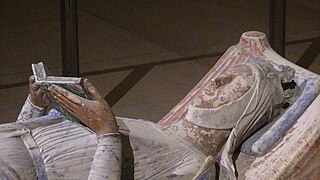
Eleanor of Aquitaine was Duchess of Aquitaine in her own right from 1137 to 1204, Queen of France from 1137 to 1152 as the wife of King Louis VII, and Queen of England from 1154 to 1189 as the wife of King Henry II. As the heiress of the House of Poitiers, which controlled much of southwestern France, she was one of the wealthiest and most powerful women in Western Europe during the High Middle Ages. Militarily, she was a leading figure in the Second Crusade, and in a revolt in favour of her son. Culturally, she was a patron of poets such as Wace, Benoît de Sainte-Maure, and Bernart de Ventadorn, and of the arts of the High Middle Ages.

Richard I, known as Richard Cœur de Lion or Richard the Lionheart because of his reputation as a great military leader and warrior, was King of England from 1189 until his death in 1199. He also ruled as Duke of Normandy, Aquitaine, and Gascony; Lord of Cyprus; Count of Poitiers, Anjou, Maine, and Nantes; and was overlord of Brittany at various times during the same period. He was the third of five sons of Henry II of England and Eleanor of Aquitaine and was therefore not expected to become king, but his two elder brothers predeceased their father.

Henry the Lion, also known as Henry III, Duke of Saxony and Henry XII, Duke of Bavaria, was a member of the Welf dynasty.

Geoffrey V, called the Handsome, the Fair or Plantagenet, was the Count of Anjou, Touraine and Maine by inheritance from 1129, and also Duke of Normandy by his marriage claim, and conquest, from 1144.

Geoffrey II was Duke of Brittany and 3rd Earl of Richmond between 1181 and 1186, through his marriage to Constance, Duchess of Brittany. Geoffrey was the fourth of five sons of Henry II of England and Eleanor, Duchess of Aquitaine.
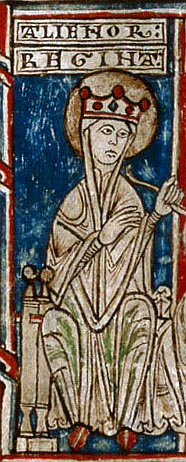
Eleanor of England, was Queen of Castile and Toledo as wife of Alfonso VIII of Castile. She was the sixth child and second daughter of Henry II, King of England, and Eleanor of Aquitaine. She served as Regent of Castile during the minority of her son Henry I for 26 days between the death of her spouse and her own death in 1214.

The Duchy of Saxony was originally the area settled by the Saxons in the late Early Middle Ages, when they were subdued by Charlemagne during the Saxon Wars from 772 and incorporated into the Carolingian Empire (Francia) by 804. Upon the 843 Treaty of Verdun, Saxony was one of the five German stem duchies of East Francia; Duke Henry the Fowler was elected German king in 919.

The House of Welf is a European dynasty that has included many German and British monarchs from the 11th to 20th century and Emperor Ivan VI of Russia in the 18th century. The originally Franconian family from the Meuse-Moselle area was closely related to the imperial family of the Carolingians.
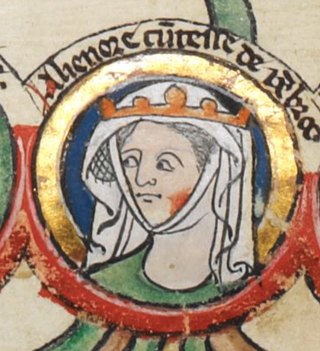
Eleanor of England was the youngest child of John, King of England and Isabella of Angoulême.

The term Angevin Empire describes the possessions held by the House of Plantagenet during the 12th and 13th centuries, when they ruled over an area covering roughly all of present-day England, half of France, and parts of Ireland and Wales, and had further influence over much of the remaining British Isles. It may be described as an early example of a composite monarchy. The empire was established by Henry II of England, who succeeded his father Geoffrey as Duke of Normandy and Count of Anjou. Henry married Eleanor of Aquitaine in 1152, acquiring the Duchy of Aquitaine, and inherited his mother Empress Matilda's claim to the English throne, succeeding his rival Stephen in 1154. Although their title of highest rank came from the Kingdom of England, the Plantagenets held court primarily on the continent at Angers in Anjou, and at Chinon in Touraine.
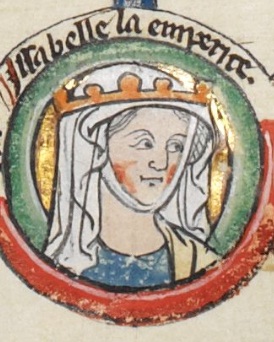
Isabella of England was an English princess of the House of Plantagenet. She became Holy Roman Empress, Queen of Sicily, Italy and Germany from 1235 until her death as the third wife of Emperor Frederick II.

The House of Plantagenet was a royal house which originated in the French County of Anjou. The name Plantagenet is used by modern historians to identify four distinct royal houses: the Angevins, who were also Counts of Anjou; the main line of the Plantagenets following the loss of Anjou; and the houses of Lancaster and York, two of the Plantagenets cadet branches. The family held the English throne from 1154, with the accession of Henry II, until 1485, when Richard III died.
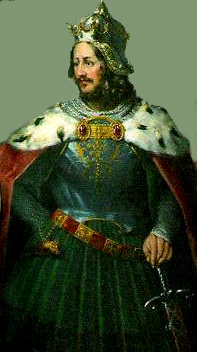
William of Winchester, also called in English William of Lunenburg or William Longsword, a member of the House of Welf, was heir to his family's allodial lands in the Duchy of Saxony after the deposition of his father, Duke Henry the Lion in 1180.

Richenza of Northeim was Duchess of Saxony from 1106, Queen of Germany from 1125 and Holy Roman Empress from 1133 as the wife of Lothair of Supplinburg.

Gertrude of Süpplingenburg was Duchess of Bavaria, Margravine of Tuscany, and Duchess of Saxony by marriage to Henry X, Duke of Bavaria, and Margravine of Austria and Duchess of Bavaria by marriage to Henry II, Duke of Austria. She was regent of Saxony during the minority of her son Henry the Lion in 1139–1142.

Henry V, the Elder of Brunswick, a member of the House of Welf, was Count Palatine of the Rhine from 1195 until 1212.
William FitzEmpress or William Longespee was the youngest of the three sons of Empress Matilda and Geoffrey Plantagenet, Count of Anjou. His brothers were Henry II of England and Geoffrey, Count of Nantes.
Geoffrey VI was Count of Nantes from 1156 to 1158. He was also known as Geoffrey of Anjou and Geoffrey FitzEmpress. He was the son of Geoffrey Plantagenet and Empress Matilda. His brothers were Henry II of England and William FitzEmpress.

The Angevin kings of England were Henry II and his sons, Richard I and John, who ruled England from 1154 to 1216. With ancestral lands in Anjou, they were related to the Norman kings of England through Matilda, the daughter of Henry I, and Henry II's mother. They were also related to the earlier Anglo-Saxon kings of England through Matilda's great-great-great grandfather, Aethelred the Unready. Their descendants, the main line of Plantagenets, continued to rule England until 1485; some historians make no distinction between the Angevins and the Plantagenets, while others name John's son Henry III the first Plantagenet king.
Matilda of Saxony, or Richenza of Saxony was the Countess of Perche followed by the title of Lady of Coucy from the German Welf dynasty. She was also the niece of Richard the Lionheart.
References
- 1 2 3 Weir 2011, p. 62.
- 1 2 3 4 5 6 7 8 9 10 Panton 2011, p. 342.
- 1 2 3 4 5 6 Norgate 1894, p. 58.
- 1 2 3 4 5 6 7 8 9 10 11 Norgate 1894, p. 59.
- ↑ Diggelmann 2005, pp. 1–16.
- 1 2 Weir 2011, p. 63.
- ↑ Weir 2011, pp. 62–63.
- ↑ Leese 1996, p. 42.
- 1 2 Jordan 1986, p. 183.
- ↑ Jordan 1986, p. 185.
- ↑ Jordan 1986, pp. 192–194.
- ↑ Jordan 1986, p. 197.
- ↑ Jordan 1986, p. 192.
- ↑ Chronicon Sancti Michaelis Luneburgensis, MGH SS XXIII, p. 397.
Sources
- Diggelmann, Lindsay (2005). "Exile and the Poetic Standpoint of the Troubadour Bertran de Born". Parergon. 22. Australian and New Zealand Association of Medieval and Early Modern Studies (Inc.): 1–16. doi:10.1353/pgn.2005.0018. S2CID 145553555.
- Jordan, Karl (1986). Henry the Lion: A Biography. Falla, P. S. (trans.). Oxford: Clarendon Press. ISBN 978-0198219699.
- Leese, Thelma Anna (1996). Blood Royal: Issue of the Kings and Queens of Medieval England, 1066-1399 : the Normans and Plantagenets. Heritage Books. ISBN 978-0788405259.
- Norgate, Kate (1894). Sidney Lee (ed.). "Matilda (1156-1189)". Dictionary of National Biography. London: Smith, Elder & Co. pp. 58–59.